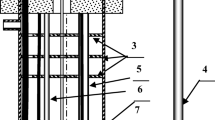Abstract
Values of the contact angle of wetting of a surface of glassy carbon by molten chlorides of lithium, sodium, potassium, and cesium are measured by the meniscus weight method to determine the common factors of wettability of solid surfaces by ionic melts upon a change in the salt phase composition and a jump in electric potential. It is found that with a potential shift in the positive direction the shape of the curve of the contact angle’s dependence on the potential varies upon substitution of one salt by another: the angle of wetting shrinks monotonously in lithium chloride but remains constant in molten cesium chloride. This phenomenon is explained by the hypothesis that the nature of the halide anion adsorption on the positively charged surface of an electrode is chemical and not electrostatic. It is shown that the adsorption process is accompanied by charge transfer through the interface, with covalent bonding between the adsorbent and adsorbate.
Similar content being viewed by others
References
A. Adamson, The Physical Chemistry of Surfaces (Wiley, New York, 1976).
P. G. de Gennes, Rev. Mod. Phys. 57, 827 (1985).
F. Mugele and J.-C. Baret, J. Phys.: Condens. Matter 17, 705 (2005).
J. Morcos, J. Electroanal. Chem. 62, 313 (1975).
Yu. I. Aleksandrov and V. P. Mashovets, Zh. Prikl. Khim. 39, 2591 (1966).
A. Fontana and R. Winand, J. Nucl. Mater. 35, 87 (1970).
H. Vogt, J. Appl. Electrochem. 29, 137 (1999).
N. P. Kulik, L. V. Sitnikov, L. M. Babushkina, et al., Rasplavy, No. 5, 37 (2006).
A. V. Frolov, A. O. Gusev, N. I. Shurov, et al., in Proceedings of the TMS Annual Meeting on Light Metals (The Minerals, Met. Mater. Soc., 2006), p. 645.
L. M. Babushkina, L. V. Sitnikov, N. P. Kulik, et al., Rasplavy, No. 6, 63 (2004).
G. V. Forsblom and E. G. Goldelenok, Tsvetn. Metall., No. 1, 43 (1958).
N. A. Uzikova, G. A. Kolyagin, V. G. Danilov, and I. A. Kedrinskii, Zh. Prikl. Khim. 52, 1249 (1979).
K. A. Aleksandrov, V. P. Stepanov, and M. V. Smirnov, Zh. Prikl. Khim. 54, 162 (1981).
L. Suski, A. Godula-Jopek, and J. Oblakowski, J. Electrochem. Soc. 146, 4048 (1998).
V. S. Belyaev, L. M. Babushkina, I. V. Yakshevich, and V. P. Stepanov, Kolloidn. Zh. 57, 469 (1995).
V. P. Stepanov, I. V. Yakshevich, and V. S. Belyaev, Z. Phys. Chem. B 214, 359 (2000).
M. Matsumura and J. R. Selman, J. Electrochem. Soc. 139, 1255 (1992).
J. M. Fisher, P. S. Bennett, J. F. Pignon, et al., J. Electrochem. Soc. 137, 1493 (1990).
M. Kavase, Y. Mugikura, and T. Watanabe, J. Electrochem. Soc. 147, 854 (2000).
R. W. Warren, Rev. Sci. Instrum. 36, 731 (1965).
V. Yu. Shishkin and V. S. Mityaev, Izv. Akad. Nauk SSSR, Neorg. Mater. 18, 1917 (1982).
A. Ya. Gokhshtein, Dokl. Akad. Nauk SSSR 224, 1105 (1975).
M. V. Smirnov, K. A. Aleksandrov, and V. A. Khokhlov, Electrochim. Acta 22, 543 (1977).
V. P. Stepanov, The Interphase Phenomena in Ionic Salt Melts (Nauka, Yekaterinburg, 1993) [in Russian].
O. K. Davtyan, Quantum Chemistry (Vyssh. Shkola, Moscow, 1962) [in Russian].
N. G. Bukun and R. A. Alekseeva, Elektrokhimiya 11, 1738 (1975).
S. I. Dokashenko, E. V. Kirillova, and V. P. Stepanov, Rasplavy, No. 4, 47 (2004).
E. V. Kirillova, S. I. Dokashenko, and V. P. Stepanov, Rasplavy, No. 4, 74 (2008).
E. V. Kirillova, S. I. Dokashenko, and V. P. Stepanov, Rasplavy, No. 5, 35 (2007).
V. P. Stepanov and V. S. Belyaev, Elektrokhimiya 30, 1115 (1994).
Yu. G. Pastukhov and V. P. Stepanov, Dokl. Akad. Nauk SSSR 307, 648 (1989).
S. Tazi, M. Salanne, Ch. Simon, et al., J. Phys. Chem. B 114, 8453 (2010).
R. Puddephat, The Chemistry of Gold (Elsevier, Amsterdam, 1978; Mir, Moscow, 1982).
F. G. Fumi and M. P. Tosi, J. Phys. Chem. Solids 25, 31 (1964).
Author information
Authors and Affiliations
Corresponding author
Rights and permissions
About this article
Cite this article
Stepanov, V.P. Wetting of a Charged Surface of Glassy Carbon by Molten Alkali-Metal Chlorides. Russ. J. Phys. Chem. 92, 570–574 (2018). https://doi.org/10.1134/S0036024418030287
Received:
Published:
Issue Date:
DOI: https://doi.org/10.1134/S0036024418030287



